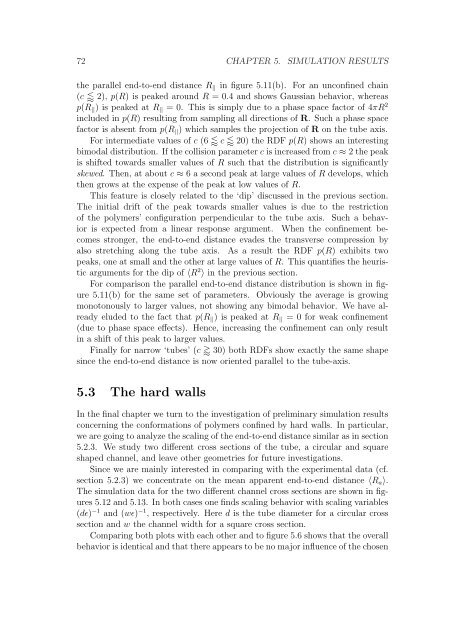Polymers in Confined Geometry.pdf
Polymers in Confined Geometry.pdf
Polymers in Confined Geometry.pdf
Create successful ePaper yourself
Turn your PDF publications into a flip-book with our unique Google optimized e-Paper software.
72 CHAPTER 5. SIMULATION RESULTS<br />
the parallel end-to-end distance R|| <strong>in</strong> figure 5.11(b). For an unconf<strong>in</strong>ed cha<strong>in</strong><br />
(c 2), p(R) is peaked around R = 0.4 and shows Gaussian behavior, whereas<br />
p(R||) is peaked at R|| = 0. This is simply due to a phase space factor of 4πR 2<br />
<strong>in</strong>cluded <strong>in</strong> p(R) result<strong>in</strong>g from sampl<strong>in</strong>g all directions of R. Such a phase space<br />
factor is absent from p(R||) which samples the projection of R on the tube axis.<br />
For <strong>in</strong>termediate values of c (6 c 20) the RDF p(R) shows an <strong>in</strong>terest<strong>in</strong>g<br />
bimodal distribution. If the collision parameter c is <strong>in</strong>creased from c ≈ 2 the peak<br />
is shifted towards smaller values of R such that the distribution is significantly<br />
skewed. Then, at about c ≈ 6 a second peak at large values of R develops, which<br />
then grows at the expense of the peak at low values of R.<br />
This feature is closely related to the ‘dip’ discussed <strong>in</strong> the previous section.<br />
The <strong>in</strong>itial drift of the peak towards smaller values is due to the restriction<br />
of the polymers’ configuration perpendicular to the tube axis. Such a behavior<br />
is expected from a l<strong>in</strong>ear response argument. When the conf<strong>in</strong>ement becomes<br />
stronger, the end-to-end distance evades the transverse compression by<br />
also stretch<strong>in</strong>g along the tube axis. As a result the RDF p(R) exhibits two<br />
peaks, one at small and the other at large values of R. This quantifies the heuristic<br />
arguments for the dip of 〈R 2 〉 <strong>in</strong> the previous section.<br />
For comparison the parallel end-to-end distance distribution is shown <strong>in</strong> figure<br />
5.11(b) for the same set of parameters. Obviously the average is grow<strong>in</strong>g<br />
monotonously to larger values, not show<strong>in</strong>g any bimodal behavior. We have already<br />
eluded to the fact that p(R||) is peaked at R|| = 0 for weak conf<strong>in</strong>ement<br />
(due to phase space effects). Hence, <strong>in</strong>creas<strong>in</strong>g the conf<strong>in</strong>ement can only result<br />
<strong>in</strong> a shift of this peak to larger values.<br />
F<strong>in</strong>ally for narrow ‘tubes’ (c 30) both RDFs show exactly the same shape<br />
s<strong>in</strong>ce the end-to-end distance is now oriented parallel to the tube-axis.<br />
5.3 The hard walls<br />
In the f<strong>in</strong>al chapter we turn to the <strong>in</strong>vestigation of prelim<strong>in</strong>ary simulation results<br />
concern<strong>in</strong>g the conformations of polymers conf<strong>in</strong>ed by hard walls. In particular,<br />
we are go<strong>in</strong>g to analyze the scal<strong>in</strong>g of the end-to-end distance similar as <strong>in</strong> section<br />
5.2.3. We study two different cross sections of the tube, a circular and square<br />
shaped channel, and leave other geometries for future <strong>in</strong>vestigations.<br />
S<strong>in</strong>ce we are ma<strong>in</strong>ly <strong>in</strong>terested <strong>in</strong> compar<strong>in</strong>g with the experimental data (cf.<br />
section 5.2.3) we concentrate on the mean apparent end-to-end distance 〈Ra〉.<br />
The simulation data for the two different channel cross sections are shown <strong>in</strong> figures<br />
5.12 and 5.13. In both cases one f<strong>in</strong>ds scal<strong>in</strong>g behavior with scal<strong>in</strong>g variables<br />
(dɛ) −1 and (wɛ) −1 , respectively. Here d is the tube diameter for a circular cross<br />
section and w the channel width for a square cross section.<br />
Compar<strong>in</strong>g both plots with each other and to figure 5.6 shows that the overall<br />
behavior is identical and that there appears to be no major <strong>in</strong>fluence of the chosen













